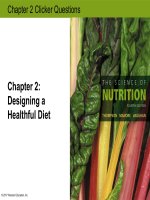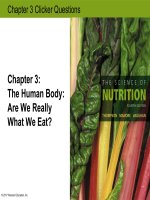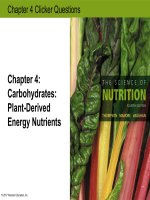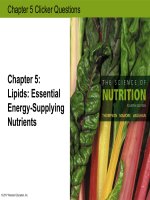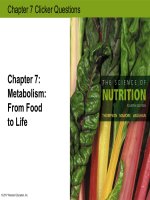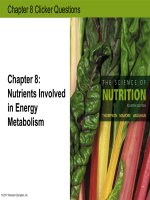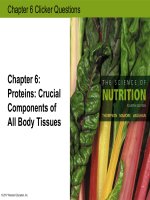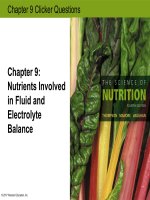Clicker questions the science of NUTRITON 4th by thompson manore and vaughan chapter 13
Bạn đang xem bản rút gọn của tài liệu. Xem và tải ngay bản đầy đủ của tài liệu tại đây (338.55 KB, 21 trang )
Chapter 12 Clicker Questions
Chapter 12:
Nutrients
Involved in
Blood Health
and Immunity
© 2017 Pearson Education, Inc.
Erythrocytes
a)
are essential for the transport of glucose, albumin, and many other solutes throughout
the body.
b)
lack a nucleus and mitochondria, and are filled
with hemoglobin, which is essential for oxygen transport.
c)
d)
are involved in both non-specific and specific immunity.
are produced in the liver, whereas leukocytes and platelets are produced in the bone
marrow.
© 2017 Pearson Education, Inc.
Erythrocytes
a)
are essential for the transport of glucose, albumin, and many other solutes throughout
the body.
b)
lack a nucleus and mitochondria, and are filled with hemoglobin, which is
essential for oxygen transport.
c)
d)
are involved in both non-specific and specific immunity.
are produced in the liver, whereas leukocytes and platelets are produced in the bone
marrow.
© 2017 Pearson Education, Inc.
Which of the following statements about iron is true?
a)
b)
c)
d)
© 2017 Pearson Education, Inc.
Every molecule of hemoglobin contains one atom of iron.
Iron is a component of hemoglobin, the oxygen-transport protein within red blood cells.
Iron in myoglobin accounts for about one-third of total iron in the body.
All of these statements are true.
Which of the following statements about iron is true?
a)
b)
Every molecule of hemoglobin contains one atom of iron.
Iron is a component of hemoglobin, the oxygen-transport protein within red blood
cells.
c)
d)
© 2017 Pearson Education, Inc.
Iron in myoglobin accounts for about one-third of total iron in the body.
All of these statements are true.
Jenna is an ovo-lacto vegetarian concerned about her iron intake. From which of the
following breakfasts is she likely to absorb the greatest percentage of iron?
a)
b)
c)
a bowl of iron-fortified cereal with cow's milk, and a cup of coffee
a bowl of iron-fortified cereal with soy milk, and a cup of tea
an iron-fortified breakfast bar with a glass of
orange juice
d)
© 2017 Pearson Education, Inc.
a cheese croissant and a diet coke
Jenna is an ovo-lacto vegetarian concerned about her iron intake. From which of the
following breakfasts is she likely to absorb the greatest percentage of iron?
a)
b)
c)
d)
© 2017 Pearson Education, Inc.
a bowl of iron-fortified cereal with cow's milk, and a cup of coffee
a bowl of iron-fortified cereal with soy milk, and a cup of tea
an iron-fortified breakfast bar with a glass of orange juice
a cheese croissant and a diet coke
A classic sign of stage I iron-deficiency is
a)
b)
c)
d)
© 2017 Pearson Education, Inc.
reduced levels of circulating ferritin.
a significantly elevated total iron binding capacity.
smaller than normal red blood cells that are pale in color.
exhaustion, impaired cognitive functions, and increased risk for infection.
A classic sign of stage I iron-deficiency is
a)
b)
c)
d)
© 2017 Pearson Education, Inc.
reduced levels of circulating ferritin.
a significantly elevated total iron binding capacity.
smaller than normal red blood cells that are pale in color.
exhaustion, impaired cognitive functions, and increased risk for infection.
Zinc plays an important role in
a)
b)
c)
d)
© 2017 Pearson Education, Inc.
heme synthesis.
maintaining the structural integrity of iron.
preventing copper deficiency.
reducing the risk for pernicious anemia.
Zinc plays an important role in
a)
b)
c)
d)
© 2017 Pearson Education, Inc.
heme synthesis.
maintaining the structural integrity of iron.
preventing copper deficiency.
reducing the risk for pernicious anemia.
Good food sources of copper include
a)
b)
c)
d)
© 2017 Pearson Education, Inc.
green, leafy vegetables and fortified grain products.
green, leafy vegetables and dairy products.
red, orange, and yellow fruits and vegetables.
organ meats, seafood, nuts, and seeds.
Good food sources of copper include
a)
b)
c)
d)
© 2017 Pearson Education, Inc.
green, leafy vegetables and fortified grain products.
green, leafy vegetables and dairy products.
red, orange, and yellow fruits and vegetables.
organ meats, seafood, nuts, and seeds.
The physiologic function most closely associated with vitamin K is
a)
b)
c)
d)
© 2017 Pearson Education, Inc.
synthesis of heme.
blood clotting.
formation of the embryonic neural tube.
maintenance of the myelin sheath.
The physiologic function most closely associated with vitamin K is
a)
b)
c)
d)
© 2017 Pearson Education, Inc.
synthesis of heme.
blood clotting.
formation of the embryonic neural tube.
maintenance of the myelin sheath.
Vitamin B6, folate, and vitamin B12 are all
required for
a)
b)
c)
d)
© 2017 Pearson Education, Inc.
the formation of the porphyrin rings in heme.
the function of platelets.
erythropoiesis.
hemochromatosis.
Vitamin B6, folate, and vitamin B12 are all
required for
a)
b)
c)
d)
© 2017 Pearson Education, Inc.
the formation of the porphyrin rings in heme.
the function of platelets.
erythropoiesis.
hemochromatosis.
Which of the following cells produce antibodies involved in specific immune
responses?
a)
b)
c)
d)
© 2017 Pearson Education, Inc.
plasma cells
NK cells
macrophages
neutrophils
Which of the following cells produce antibodies involved in specific immune
responses?
a)
b)
c)
d)
© 2017 Pearson Education, Inc.
plasma cells
NK cells
macrophages
neutrophils
A sensitive indicator of reduced nutritional status is
a)
b)
c)
d)
© 2017 Pearson Education, Inc.
nausea and vomiting.
fatigue and weakness.
inflammation.
decreased immunocompetence.
A sensitive indicator of reduced nutritional status is
a)
b)
c)
d)
© 2017 Pearson Education, Inc.
nausea and vomiting.
fatigue and weakness.
inflammation.
decreased immunocompetence.

